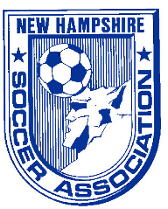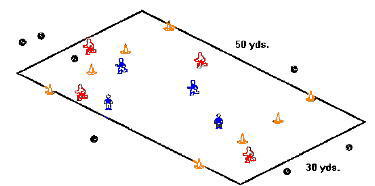
It is imperative that coaches get the parents involved. Not only are they are a major resource for your team, but the U-10 player still views their parents as the most significant people in their lives. A pre-season meeting should be held with the parents so that objectives and team policies can be addressed. Some topics that you may want to address at this meeting are:
Some coaches say that the 9 and 10 year-old players are beginning to "turn the corner" and starting to look like real soccer players. However, games are still frantically paced and unpredictable for the most part. These players are starting to find out how much fun it is to play the game skillfully, but they will still stop and laugh if the referee gets hit in the backside with the ball during a game. Some other things that we can expect when working with this aged player are:
Some of the players that are playing as U - 10's are seasoned veterans of the youth soccer scene. Some of them may have already been involved in traveling to play in tournaments. As a result, some of them might be very nervous about the whole process. It is our job to keep things in perspective for these young, developing players. True, some of them are becoming quite skillful and are seeing how fun it is to play the game when they can really control the ball. However, many of them are still learning the ropes. Even the more experienced players need to have the game be fun!!!
Emphasis is still placed on having players learn how to control the ball with his/her body, but now, they need to find themselves in more game-like situations. Training is more dynamic and starting to have players make simple, basic decisions such as "Which way is there more space?" or "Who should I pass to?".
Following are some more items that a coach of U-10 players should consider:
Here are some items that should be included in a U-10 training session:
WARM-UP: A brief warm-up is appropriate in order to get the players thinking about soccer and to prepare them physically for the time ahead. This should involve individual body activities that involve the ball. Since there can be one theme to the session, hopefully, the warm-up will lead into the theme of the day. Static stretching is also appropriate at this time after the players have broken a sweat, again, hopefully done with the ball. Again, the warm-up should get the players ready to play. It should be lively, fun, and engaging as well as instructional. There is nothing like a good, fast paced activity to grab the player's attention and make them glad that they came to practice.
INDIVIDUAL OR SMALL GROUP ACTIVITIES: Follow the warm-up with some kind of individual activity, not necessarily a real 1v.1 game, but some kind of activity where players act as individuals or cooperate in small groups in a game environment. An example would be a kind of tag game, or a keep-away game. Keep players in motion at all times. Avoid having them wait on lines. Play games of "inclusion" instead of games where the "looser sits". Be creative. These players like "crazy" games with a lot of action.
PLAY THE GAME: Small sided soccer can be used to heighten intensity and create some good competition. Play 4 v.4 up to 8 v.8. Be creative. Play with 4 goals, or 2 balls. Play with or without boundaries. Perhaps play to emphasize a particular skill (can only dribble the ball over a goal line in order to get a point). Use cones if you don't have real goals. Keep players involved. Have more than one game going on at a time if necessary. Switch teams often, give everyone a chance to win. Also, it is important that every player has a chance to shoot on goal as often as possible.
WARM-DOWN & HOMEWORK: Finish the session with a warm down. Give them some more stretches to do with the ball. You may want to review what you started the session with. Also, give them some homework so that they practice on their own. Think of some ball trick that you would like to see them try to do, like, bounce it off their head, then thigh, then foot, and then catch it. Can one player kick a ball to a partner and then back without it hitting the ground? Can they do that with their heads? It is important to finish on time. This is especially essential if the players are really into it. Stop at this point and you will get an enthusiastic return.
Here is a game to use in the 'Small Group Activity' phase of the practice. It is an engaging game that is fun to play and challenges players in almost all aspects of the game.
THE GAME:
This game is good for teaching dribbling skills as players find themselves in situations where they have to dribble to keep possession as well as dribble to beat an opponent. Also, they find themselves in situations where they may have to pass to a teammate as well as find themselves playing defense as well. becasue there are so many balls, and so many goals, it is just a crazy enough game to be appreciated and enjoyed by a typical nine- year-old.

Here is a 4 v.4 game that is free flowing and gives players a lot of problems to solve. It is a good game to use towards the end of the session as it is very close to the 'real' thing.
One particularly good thing about this game is that since teams end up attacking in two, different directions, it forces players to play in different positions. They are at the back of the team when their team attacks one end-zone, while they will find themselves at the top of the team when they attack in the other direction. This is great for their development.
THE GAME:
This game also encourages players to "SPREAD OUT" and work together, which, players are starting to be able to do at this age. At first, players will be tempted to just kick the ball up the field instead of passing. With patience, and demonstration of what is possible, this game could have a dramatic impact on their ability to play attractive, skillful soccer.
Written by Jeff Pill, NHSA Director of Coaching. Special thanks to Dr. Thomas Fleck and the National Youth Coaching Staff, Bill Buren, Dr. David Carr, Dr. Ronald Quinn, Virgil Stringfield.